Service Layouts
Service Layouts manage the Agent Desktop (Gadget) behavior. For example: which records should be queried in ServiceNow to identify a caller, or how phone numbers should be translated.
This type of configuration is used to describe the service being offered to clients.
Contact Center Type
The type of the Contact Center. One can choose between "Finesse" for a UCC based Contact Center and "WxCC" for a Webex Contact Center.
The following fields apply for a Finesse Contact Center.
Name
The name of the Service Layout. The value entered here is used as a reference for further configuration.
Required: Yes
Default value: Empty
Description
Alternative text which helps to identify the Service Layout.
Required: No
Default value: Empty
Participant Lookup
Participant Lookup makes requests from the gadget to the ServiceNow platform in order to query caller information and to identify the caller.

Please note that in addition to the configuration options listed below, it is also possible to configure phone number translation rules for the participant lookup. For more information, please refer to the Phone Number Translations section.
Advanced configuration
Defines whether the default lookup should be triggered. The default lookup searches in one table and displays the fields configured in the Lookup Result. If this is not enough, the configuration can be enhanced with a script with additional possibilities.
Required: No
Default value: False
Lookup table
Specify the ServiceNow table in which to search for information. Any table the agent has read access to in the system, including custom tables, can be selected.
Required: No
Default value: User[sys_user]
Lookup query string
Available lookup parameters are:
${ani}: Automatic Number Identification- All variables listed under Possible Variables
Required: No
Default value: phoneENDSWITH${ani}^ORhome_phoneENDSWITH${ani}^ORmobile_phoneENDSWITH${ani}
Lookup result
Defines which records should be returned to the gadget. Queried data must be returned in the format: Name=${fieldA}&Role=${fieldB}&Company=${fieldC} where Name, Role and Company are fixed keys, and ${field} specifies the record value.
Depending on the participant lookup configuration, it is possible that multiple matches for the calling number are returned. A reason for this could be that various ServiceNow users or accounts have the same associated phone number. If this is the case, the fact that there is more than one matching entry will be shown on the gadget.
The agent can then use the dropdown menu to choose the caller to associate with that particular call. In addition, it is possible to choose an incident, task, or case, if the participant lookup is configured accordingly.
The item selected in the dropdown menu is then automatically associated with the Work Log Record.
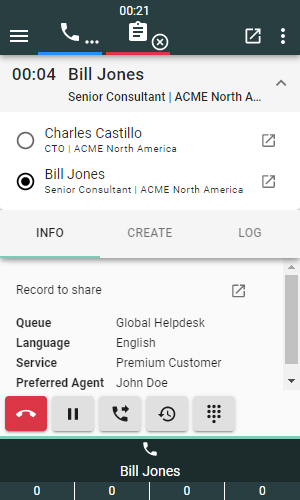
Required: No
Default value: Name=${name}&Role=${title}&Company=${company}
Please make sure that your agents have read access to the tables and fields configured in the lookup result. If the permission is missing, the agent will see null in the result instead of the expected value.
Lookup limit
Is used to define the maximum number of records to return to the gadget.
Please note: the lookup limit is related to the multi-match feature. If the limit is set to, for example, 1 but multiple matches are found, the first entry will be associated to the work item automatically.
Required: No
Default value: 5
Directory Lookup
The Directory Lookup makes requests from the gadget to the ServiceNow platform. Enter a value into the gadget's search field to use the Directory Lookup feature.
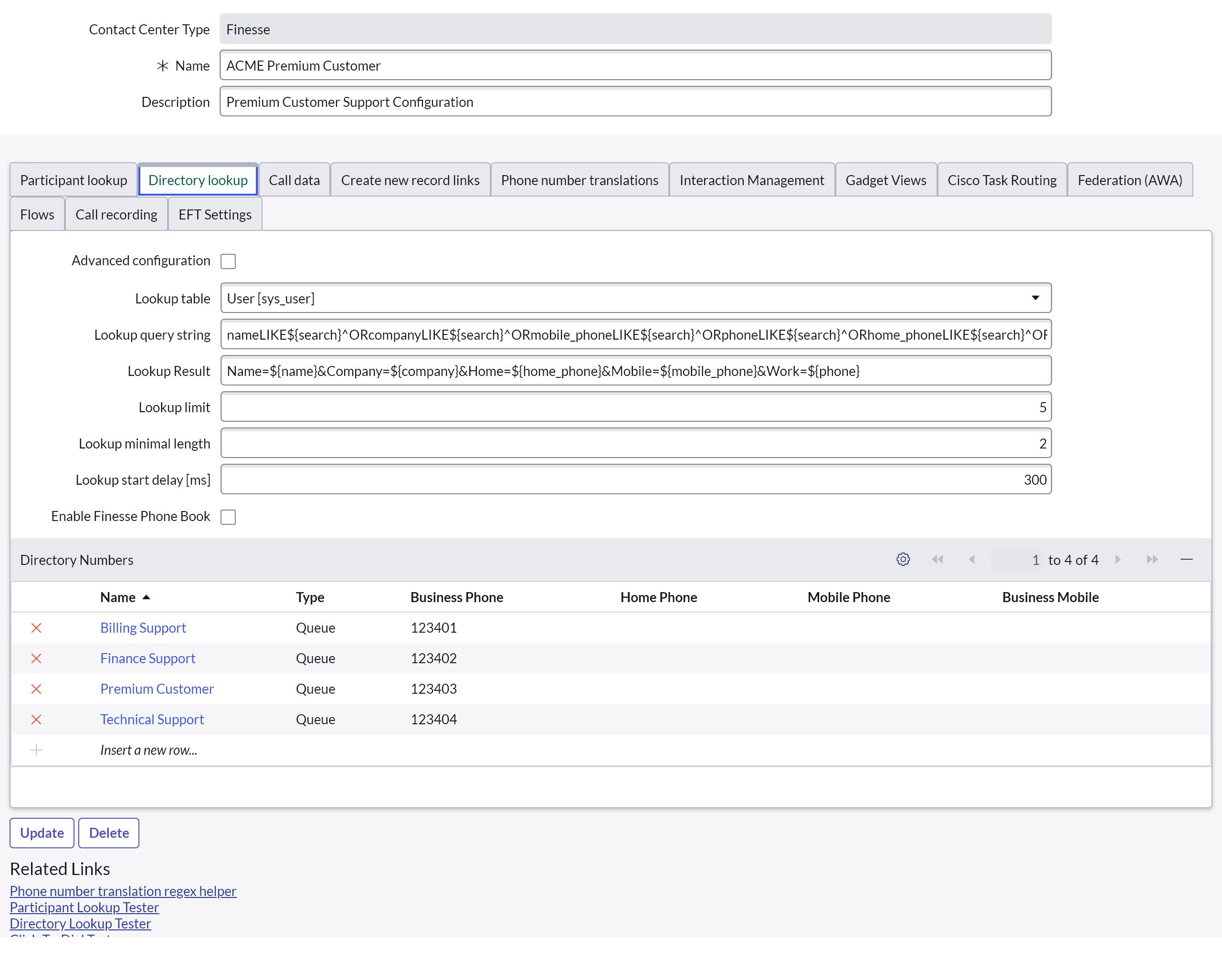
Advanced configuration
Defines whether the default lookup should be triggered. The default lookup searches in one table and displays the fields configured in the Lookup Result. If this is not enough, the configuration can be enhanced with a script providing additional functionality.
Required: No
Default value: False
Lookup table
Specify the ServiceNow table the outgoing caller should be searched for in. Any table the agent has read access to in the system, including custom tables, can be selected.
Required: No
Default value: User[sys_user]
Lookup query string
Defines which data records in a specific table are queried.
The lookup parameter is: ${search}
Required: No
Default value: nameLIKE${search}^ORcompanyLIKE${search}^ORmobile_phoneLIKE${search}^ORphoneLIKE${search}^ORhome_phoneLIKE${search}^ORDERBYname
Lookup result
Defines which records should be returned to the gadget. Queried data must be returned in the format: Name=${fieldA}&Company=${fieldB}&Home=${fieldC}&Mobile=${fieldD}&Work=${fieldF}&BusinessMobile=${fieldG} where Name, Company, Home, Mobile, Work and BusinessMobile are fixed keys and ${field} specifies the record value.
Please note the following:
- The order of the phone number fields indicates the order of the click-to-dial icons the agent sees on the gadget.
- In order to be able to see the lookup results in the gadget, your agents need to have read access to the tables and fields configured here. If the permission is missing, the agent will see
nullin the result instead of the expected value.
Required: No
Default value: Name=${name}&Company=${company}&Home=${home_phone}&Mobile=${mobile_phone}&Work=${phone}
Lookup limit
Defines the maximum number of records to return to the gadget.
Please note: values higher than five (5) will result in a scrollbar appearing in the gadget.
Required: No
Default value: 5
Lookup minimal length
Defines the minimal number of characters in search field to initiate a lookup.
This value should be increased if the table being searched has a large number of entries. It will provide more useful results and will decrease the load on the server during lookups.
Required: Yes
Default value: 2
Lookup start delay [ms]
Defines the time to wait in milliseconds between the agents search input and the execution of the lookup.
This value should be increased if the table being searched has a large number of entries. It reduces the number of search queries to the server if the search string is not typed in so quickly. Because searching in such large tables takes longer and places a heavy load on the server, unnecessary searches should be avoided.
Required: No
Default value: 300
Enable Finesse Phone Book
Enable Directory Lookup in Finesse Phone Book
Required: No
Default value: false
Requires Finesse 12.5 or higher
Directory Numbers
It is possible to define entries that can be searched within the directory lookup in order to e.g. find other queues quicker to transfer to or call. These entries have a name, a type (e.g. Queue), a description, four phone numbers to choose (home, mobile, business and business mobile) and can be assigned to multiple Service Layouts. Be aware that the order of the directory phone numbers can be changed only when using an advanced script.
Directory Numbers can be configured in the Service Layout under Directory Lookup by adding them to the Directory Numbers table. By default, the directory search will also return matching entries from the Directory Numbers table without having to configure anything.

Be aware that if a directory number is assigned to multiple Service Layouts, any changes will have an effect on all layouts that the entry is part of.
If an advanced script is used, the directory numbers have to be included in order to find them (see Directory Numbers Example).
Required: No
Default value: Empty
Call data
Defines which information from Cisco will be shown to the agent when receiving a routed call.
Items routed over a script in a Cisco Contact Center environment can be enriched with call data. This data consists of the ten call variables, ECC variables, and additional data such as call type and queue name. For a list of possible values, please check the Possible Variables section. Furthermore, the two values totalHoldTime and totalHoldCount are available. These can be used to show the agent how long (cumulative) and how often a call has been on hold.
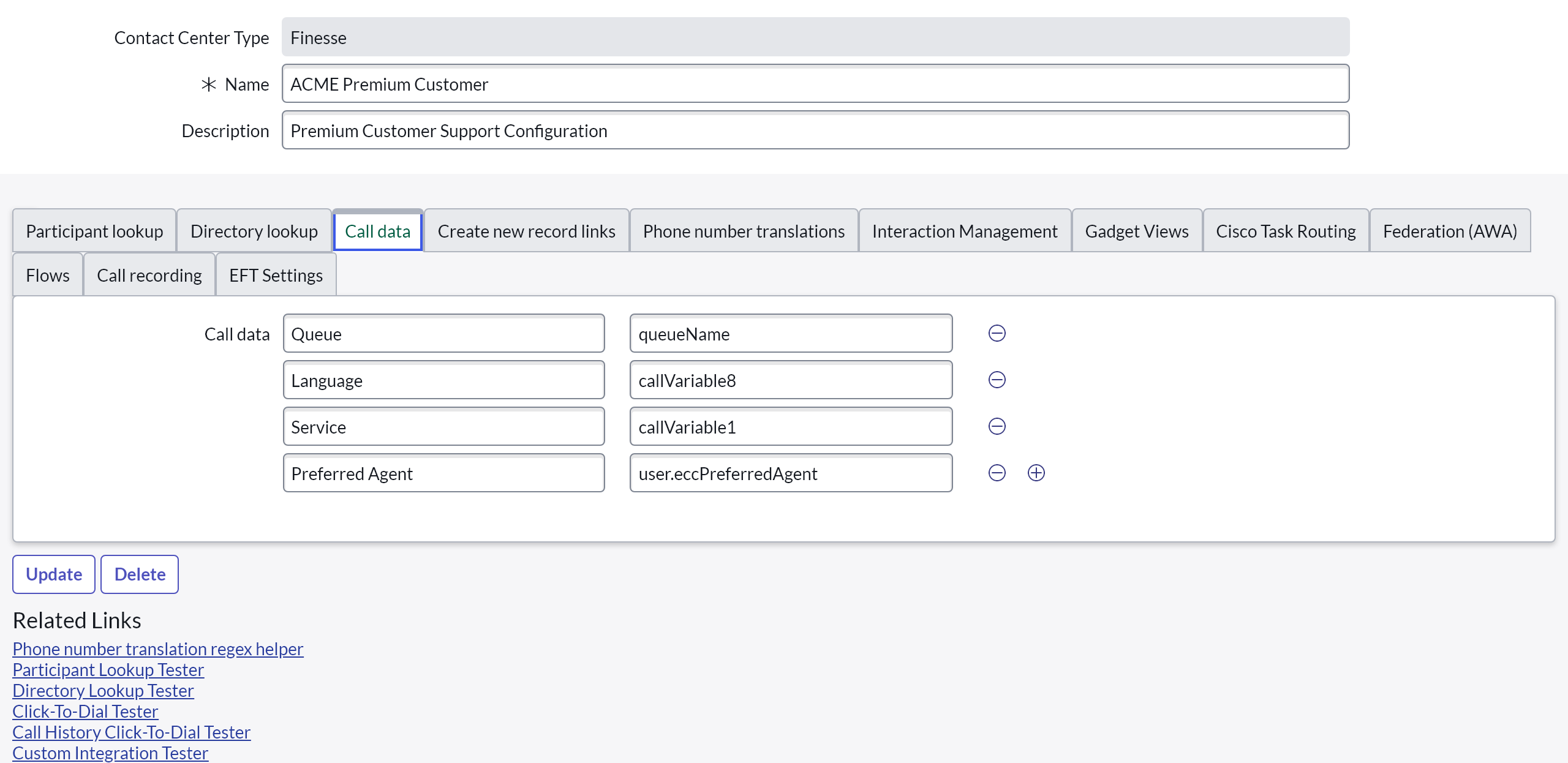
Entries can be added or removed. The first field contains the label that will be displayed and the second is the name of the call variable.
In the gadget, the configuration should appear as it does above. Note that the label Preferred Agent is not displayed. This is is either because the ECC variable user.eccPreferredAgent does not exist or is empty.
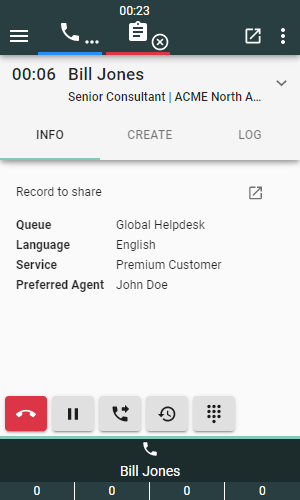
Variables that are empty or that don't exist will never be displayed.
Required: No
Default value: callVariables<1-10>
Create new record links
Create new record links are used by the agent to open URL's directly from the gadget. This way new records can be created in ServiceNow (for example, if a customer has not yet been registered) or actions can be triggered in external systems using a parameterized URL.

Depending on the configuration, agents reach the links in the "CREATE" tab:
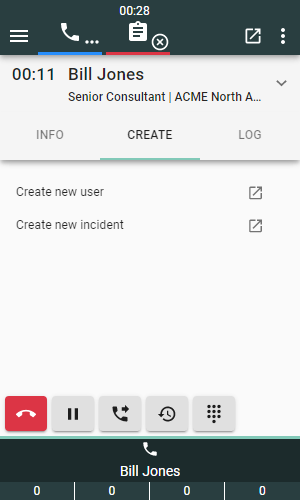
URI pointing to ServiceNow records
The format to provide is closely related to the standard URL scheme: uri={table}.do&sys_id={id}&sysparm_query={recordfieldA}=${ctidataA}^{recordfieldB}=${ctidataB}, where uri, sys_id and sysparm_query are the identifiers for the URL and {table}, {id}, {recordfields} and {ctidata} are the placeholders for the field value.
Available uri parameters are:
- Every ServiceNow table.
Available sys_id parameters are:
- -1: create new one
- id: references to a specific record
Available sysparm_query parameters are:
- All fields in the selected uri table.
For more information please see the explanation of the ServiceNow URL schema in their documentation.
Required: No
Default value: Name: Create new incident Value: uri=incident.do&sys_id=-1&sysparm_query=caller_id=${id}
URI pointing to external resources
The procedure to create a custom link for external targets is basically the same as for ServiceNow internal links. The difference is that the URL scheme changes and the address begins with "https://".
Please note: Only field values that are part of the participant lookup result can be used.
Required: No
Example: Name: Search with Google Value: https://www.google.com/search?q=${ani}
Phone number translations
With phone number translation rules you can define how phone numbers should be modified before performing a participant lookup or click-to-dial.
See Phone Number Translations for more information on how to create translation rules.
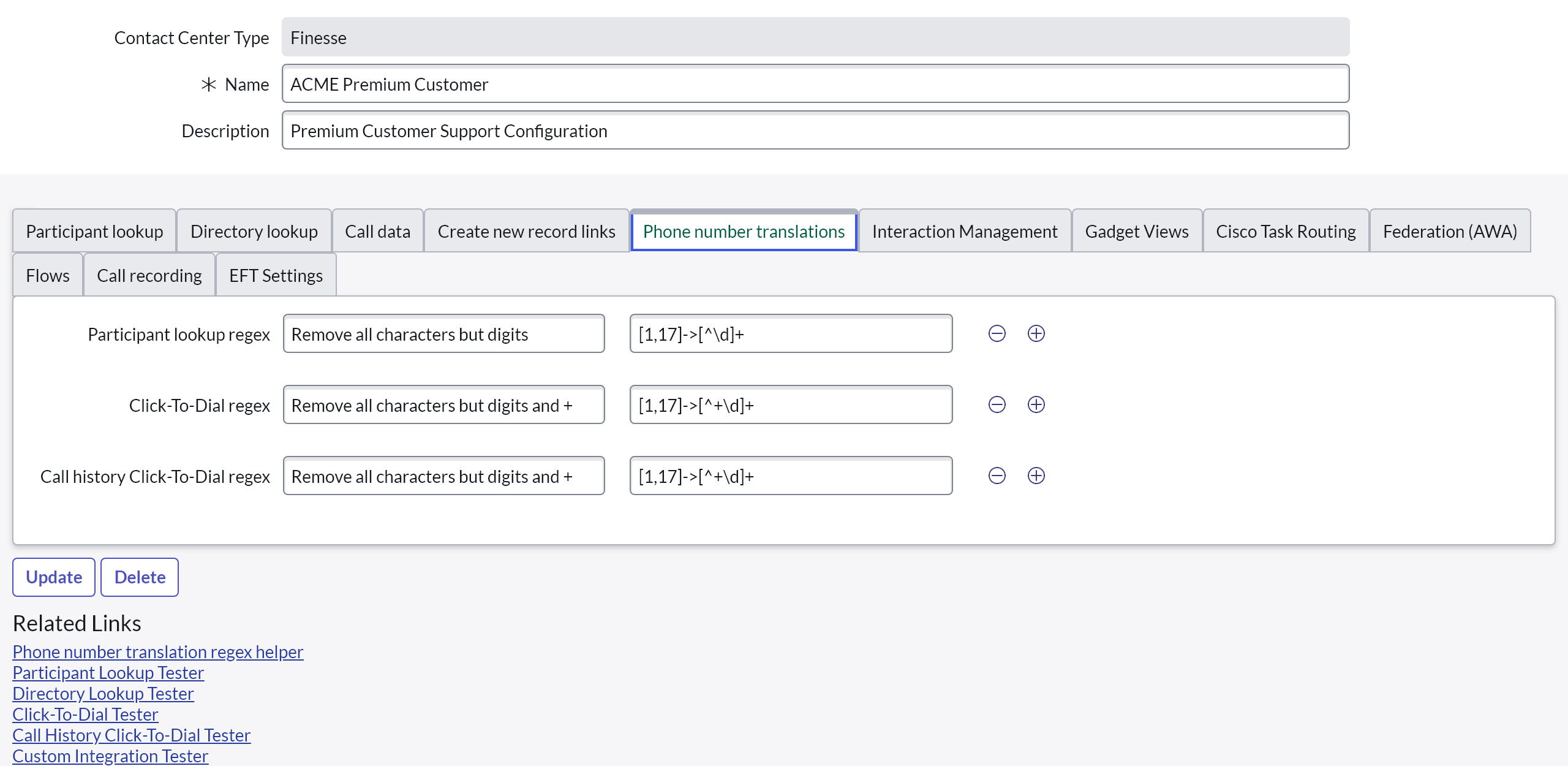
Participant lookup regex
Phone number translation rules that are applied to the ANI to identify the caller in the participant lookup.
Required: No
Default value: Empty
Click-To-Dial regex
Phone number translation rules that are applied when performing a click-to-dial action from within the CRM using the "click-to-dial" UI macro.
The "click-to-dial" UI macro can be downloaded as a ServiceNow Update Set. The UI macro then needs to be added to a field to display the icon. See Click to Dial for more information.
Required: No
Default value: Name: Remove all characters but digits and + Value: [1,17]->[^+\d]+
Call History Click-To-Dial regex
Phone number translation rules that are only applied when performing a click-to-dial action from the Call History view within the b+s Connects for ServiceNow gadget.
Required: No
Default value: Empty
Interaction Management
Interactions are a centralized location for all communication channels on the ServiceNow platform. Each interaction represents a request for assistance through a given channel, for example, a call or a chat.
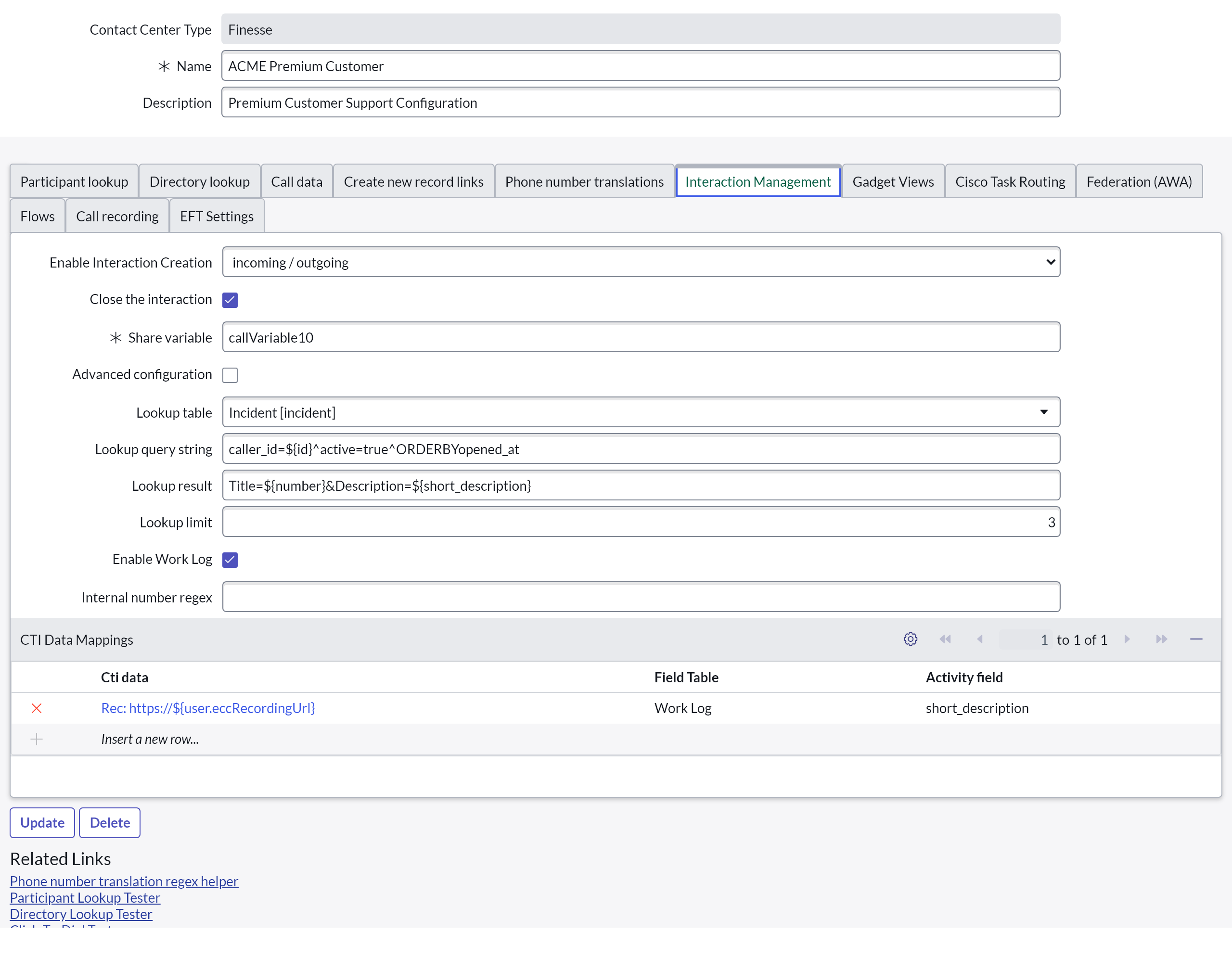
Enable Interaction Creation
This setting can be used to enable or disable the creation of interactions completely, or to only enable it for incoming calls. For the values incoming / outgoing or incoming, a new interaction will be created when a new work item is created on the b+s Connects for ServiceNow gadget, if the interaction does not already exist.
Please note that for agents with interactions disabled, it is still possible to receive transferred calls including share records from other agents.
Setting the value to disabled might cause other functionalities like storing recording links within the CRM or
Interaction Record share not to be available. Also, the Log tab won't be available to your agents.
Required: No
Default value: incoming / outgoing
Close the interaction
This setting can be used to enable or disable the automatic closing of interactions. If enabled, the interaction is closed when the work item is removed from the b+s Connects for ServiceNow gadget.
Required: No
Default value: True
Share variable
Defines a call or ECC variable as a shared variable that the Interaction entry ID will be stored in. This variable is shared for all transferred calls between agents.
This setting is only available if automatic creation of interactions is enabled.
Required: Yes
Default value: callVariable10
Advanced configuration
Defines whether the default lookup should be triggered. The default lookup searches in one table and displays the fields configured in the Lookup Result. If this is not enough, the advanced configuration can be enabled and a script with additional functionality created.
This setting is only available if automatic creation of interactions is enabled.
Required: No
Default value: False
Lookup table
Specifies the ServiceNow table that associates the interaction with an object. This can be any table the agent has read access to in the system, including custom tables.
This setting is only available if automatic creation of interactions is enabled.
Required: No
Default value: Incident[incident]
Lookup query string
The lookup parameter is:
${id}: The identifier of the result found in the participant lookup search- All variables listed under Possible Variables
This setting is only available if automatic creation of interactions is enabled.
Required: No
Default value: caller_id=${id}^active=true^ORDERBYopened_at
Lookup result
Defines which records should be returned to the gadget. Queried data must be returned in the format: Title=${fieldA}&Description=${fieldB} where Title and Description are fixed keys and ${field} specifies the record value.
This setting is only available if automatic creation of interactions is enabled.
Required: No
Default value: Title=${number}&Description=${short_description}
Lookup limit
Is used to define the maximum number of records to return to the gadget.
Please note: values higher than three (3) will result in a scrollbar appearing in the gadget. Also, this setting is only available if automatic creation of interactions is enabled.
Required: No
Default value: 3
Enable Work log
Enable the work log and all relevant information about the activity of an agent will be stored. This information can be used for specific agent activity reports.
See Work Log
Required: No
Default value: True
Internal number regex
Use this configuration key to define the format for internal numbers. There will be no interaction written for internal numbers. If the work log is enabled it will be written anyway. Leave this empty if internal numbers should not be handled separately.
Examples:
^\+123456if internal number starts with +123456^\d{4,6}$if internal numbers are 4 to 6 digits long
Required: No
Default value: Not set (empty string)
This configuration choice is only recommended when using the CSM module of ServiceNow. For the other modules the customers are often internal.
CTI Data Mappings
Data mapping can be used to store incoming Cisco CTI data within fields of an Interaction/Work Log.
See Custom Fields
Required: No
Default value: No mapping configured
Gadget Views
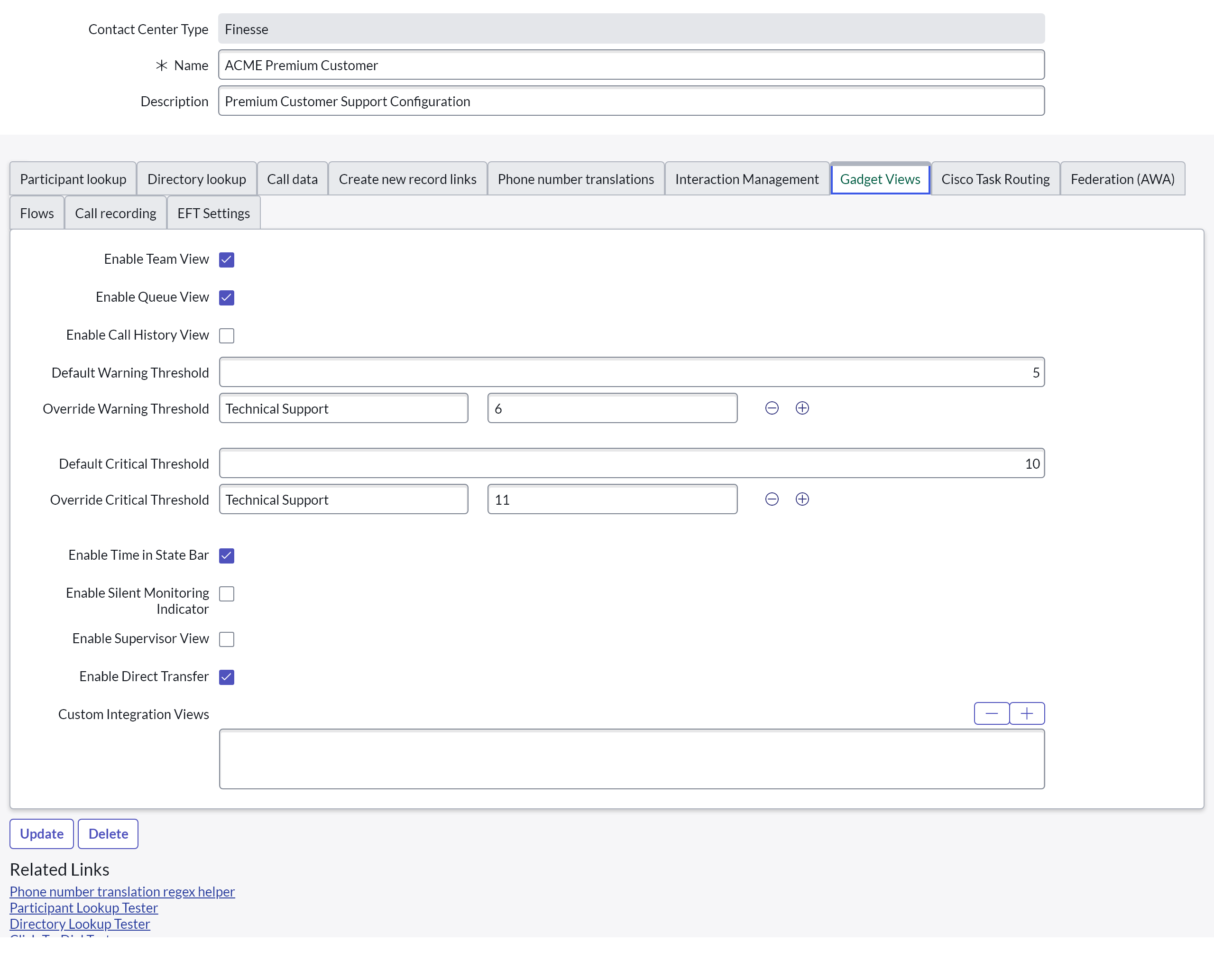
Team View
The real time Team View shows the following information on all team members:
- Agent State (including the reason when hovering over the corresponding icon)
- Name of the agent
- Time in state
- Extension (with click-to-dial button)
The "click to dial" icon is not available for the following scenarios:
- For the operating agent it's generally disabled
- When the operating agent is in a state where dialing is not allowed
- When the agent is already on a call
All columns except the "Dial" column are sortable by clicking directly on the column header. To filter the list by agent state, click on the arrow next to the title and check or uncheck the required checkboxes.
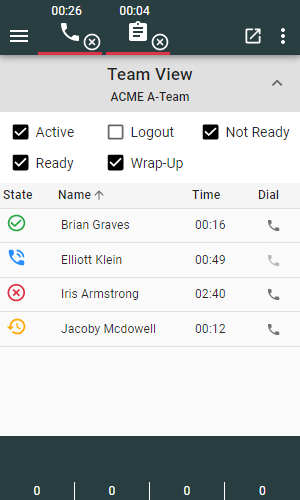
Required: No
Default value: True
A change of this configuration causes agents to be logged off if no Auto Login is configured.
Queue View
This view is not available for CCX deployments.
The real time Queue View shows the following information on all queues that the agent is assigned to:
- Queue name
- Number of Items: the number of routed items currently in this queue
- LWT: the elapsed time of the oldest item in the queue (Longest Waiting Time)
- Ready: the number of agents in
Readystate per queue
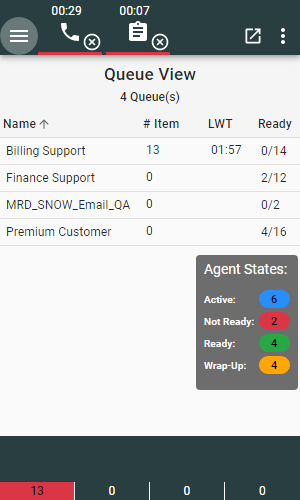
For supervisors, the real time Queue View displays the same information, but more queues appear in the list. The supervisor can also see all the queues of the supervised agents here.
When hovering over the entry in the "Ready" column, the detailed agent states for this queue are displayed.
Also here, all columns except the "Ready" column are sortable by clicking directly on the column header.
The statistics are updated every 10 seconds. Queues are automatically added or deleted when agents are reskilled while working.
For UCCE deployments, the queue name refers to the "Peripheral Name" field of a Skill Group and the "Name" field of a Precision Queue.
When additional teams are assigned to or are removed from a supervisor, the list of queues is not automatically updated. The supervisor needs to logout and re-login or reload the page in order to see the correctly updated list of queues.
Required: No
Default value: True
A change of this configuration causes agents to be logged off if no Auto Login is configured.
Call History View
Enable or disable the call history view for agents.
See Call History
Required: No
Default value: True
Please be aware that disabling the work log will result in an empty call history view.
Queue Threshold Bar
When the Queue View is enabled in the configuration, the Queue Threshold Bar is displayed automatically. The Queue Threshold Bar shows up to 5 queues the agent is assigned to and based on the configured thresholds, indicates the state of each queue. The statistics are also updated every 10 seconds.
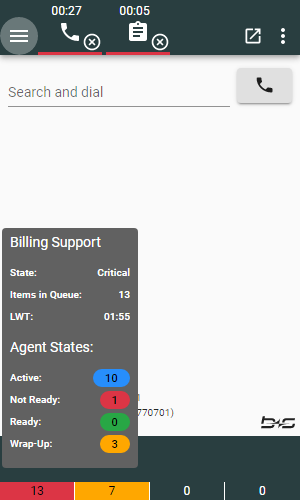
When hovering over one of the numbers on the Queue Threshold Bar more detailed information is shown on a tooltip, such as:
- Queue name (Peripheral Name for UCCE Skill Group)
- Queue state (Normal, Warning, or Critical)
- Number of items currently in queue
- Agent states (
Active,Not Ready,Ready, andWrap-Up)
The following configurations can be made to customize the thresholds:
Default Warning Threshold:
Sets the value for the number of items in queue to warn the agent. A queue that exceeds this threshold is displayed in yellow.
Override Warning Threshold:
Overrides the Default Warning Threshold for one or more queues.
Default Critical Threshold:
Sets the value for the number of items in queue where the agent is warned again. A queue that exceeds this threshold is displayed in red.
Override Critical Threshold:
Overrides the Default Critical Threshold for one or more queues.
Note that the Default Warning Threshold must always be greater than or equal to the Default Critical Threshold. In case both values are equal, the Default Critical Threshold in red will be applied.
Note that if the Override Critical Threshold is set lower than or equal to the Override Warning Threshold, the warning threshold will never be displayed.
The queue names provided with the Override Warning Threshold and Override Critical Threshold configuration are interpreted as regex literals.
By doing so, huge deployments can be simplified drastically. The consequence: Queue Names supplied without any reserved regex characters will always be compared using a case insensitive "contains" clause.
Keep in mind that the provided queue name refers to the "Peripheral Name" field of a Skill Group in UCCE deployments.
Examples:
Name:
SupportValue:10Will set a threshold of 10 on all queues which contain
Supportorsupportin their name. For example:Billing supportandTechnical Support.Name:
^Billing Support$Value:10Will set a threshold of 10 on all queues with a name equal to
Billing Supportorbilling support.Name:
su.*rtValue:10Will set a threshold of 10 on all queues containing the string
su, followed by any number of characters, then followed byrtin their name. For example:Technical SupportandSupersmart Agents.Name:
su\\.\\*rtValue:10Will escape the regex characters
.and*and therefore match queues which containsu.*rtin the name field, but will not matchsupportorsurt
A good way to start is by reading the RegExp document from the MDN web docs.
The displayed queues within the Queue Threshold Bar are ordered from left to right according to the following criteria:
Threshold:
Queues that exceed a threshold are always displayed on the far left. First the queues in "critical" state, followed by the queues in "warning" state. If there are multiple queues in the same state, they are ordered based on the number of items in the specific queue.
Number of items in queue:
After listing the queues with exceeded thresholds, the queues with the highest number of items are displayed in descending order.
Alphabetical:
Multiple queues with the same amount of items in queue are ordered alphabetically by name.
Required: No
Default value: True
Default Warning Threshold: 5
Default Critical Threshold 10
Time in State Bar
Enable or disable timers indicating how long an agent is in a given agent state (Ready or Not Ready).
Required: No
Default value: True
Silent Monitoring Indicator
Enable or disable the indicator on the agent's view when a supervisor is monitoring the call.
Required: No
Default value: True
Supervisor View
Enable or disable a dedicated view for supervisors, where functionality like the following are made available:
- Agent state monitoring
- Agent state change
- Time in state monitoring
- Silent monitoring (listening to an agent's active call)
- Click-to-Dial to call agents directly
For more information, please refer to the Supervisor documentation
Additionally, this option toggles (disables/enables) the Team Message functionality.
Required: No
Default value: True
A change in this configuration causes agents to be logged off if no Auto Login is configured.
Direct Transfer
Enable or disable the ability for agents to direct transfer customers.
For more information, please refer to Direct Transfer
Required: No
Default value: True
Custom Integration Views
Configure one or multiple custom integration views within the gadget.
For more information, please refer to Custom Integration
Required: No
Default value: Empty
Cisco Task Routing
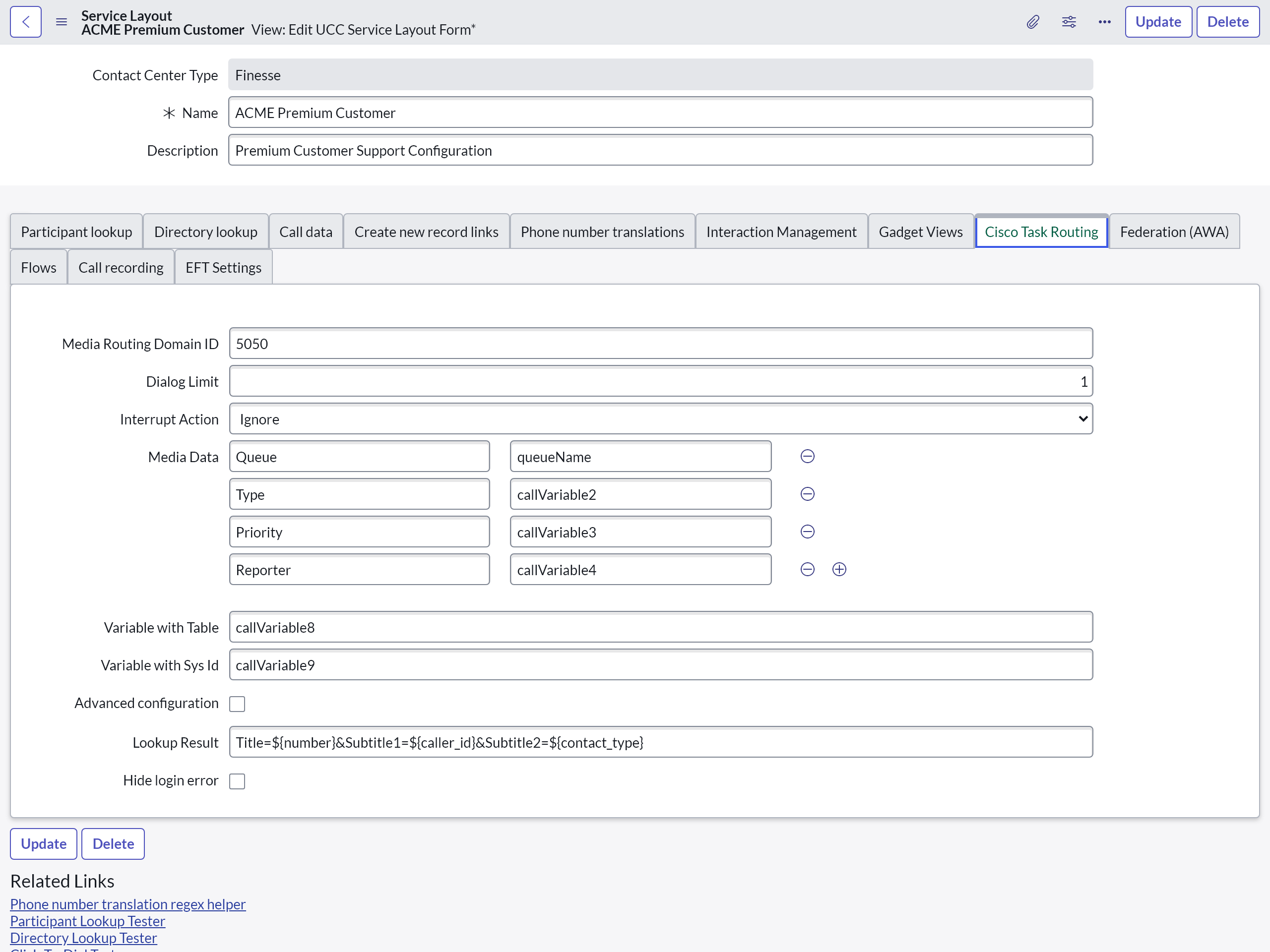
In addition to the configuration below, all requirements under Cisco Task Routing should be fully fulfilled, in order to be able to use this feature.
Media Routing Domain ID
To enable task routing, a Media Routing Domain (MRD) ID has to be configured in the Cisco Task Routing section of the Service Layout. Leaving this field empty disables the task channel.
Required: No
Default value: Empty
Dialog Limit
The maximum number of concurrent dialogs this user is allowed to handle in the MRD. Each dialog represents a task.
Required: No
Default value: 1
Interrupt Action
Defines the behavior that occurs when an agent is handling a task in an interruptible MRD and is interrupted by a task or call from a non-interruptible MRD. Finesse can ACCEPT the interrupt; the agent is put into the INTERRUPTED state and cannot work on dialogs in the interrupted MRD. Finesse can IGNORE the interrupt; the agent's state does not change and the agent can continue to work on the dialogs in the MRD.
Required: No
Default value: Ignore
Media Data
Similar to the call data, it is possible to configure different values and keys for the media channels.
Required: No
Default value: callVariables<1-10>
Variable with entity table
The routed entity table has to be written either on a "call" or "ECC" variable, to be able to retrieve the correct data when routed to an agent.
Required: No
Default value: callVariable8
Variable with Sys Id
The routed entity Sys Id has to be written either on a "call" or "ECC" variable to be able to retrieve the correct data when routed to an agent.
Required: No
Default value: callVariable9
Advanced configuration
Defines whether the default lookup should be triggered. The default lookup searches for the routed task (incident, case) and displays the fields configured in the Lookup Result. If this is not enough, the advanced configuration can be used to add a script with additional functionality.
Required: No
Default value: False
Lookup Result
Queried data must be returned in the format: Title=${fieldA}&Subtitle1=${fieldB}&Subtitle2=${fieldC} where Title, Subtitle1 and Subtitle2 are fixed keys and ${field} specifies the record value.
Required: No
Default value: Title=${number}&Subtitle1=${caller_id}&Subtitle2=${contact_type}
Hide login error
If b+s Connects for ServiceNow is used alongside Cisco Enterprise Chat and Email (ECE), it is possible to display incoming ECE chats in the gadget. For this purpose, the ECE media routing domain must be configured in the Service Layout under "Cisco Task Routing". Since it is not possible for the gadget to login an agent to an ECE media routing domain, the attempt is acknowledged with the error message "E_ARM_STAT_LOGIN_NOT_ALLOWED_FOR_APP_PATH". This error message is suppressed when this setting is turned on.
Required: No
Default value: False
Federation (AWA)
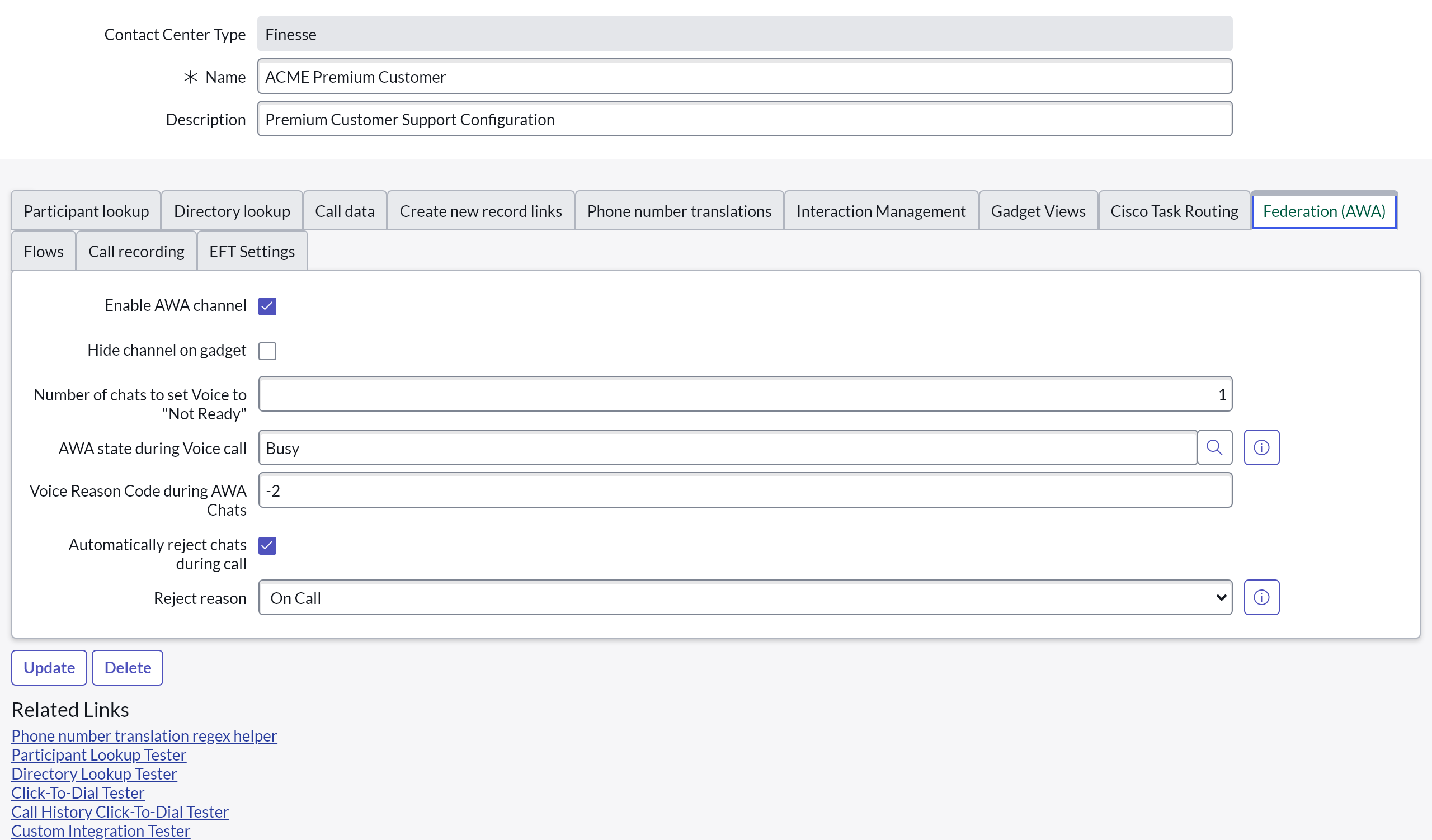
Enable AWA channel
In order to enable the Advanced Work Assignment (AWA) channel directly in the b+s Connects gadget, this setting has to be checked. This makes it possible to control the agent state for both the voice and the AWA channels from the same place. The AWA channel configuration has to be made over the normal ServiceNow configuration.
Required: No
Default value: false
Hide channel on gadget
This configuration value makes it possible to hide the federation channel on the b+s Connects gadget. This is especially useful when using the Voice channel as some kind of an overall state and to control the federation channel based on voice with the Subflow triggering feature.
Required: No
Default value: false
Number of chats to set the voice channel to "Not Ready"
Indicates how many chats an agent should have in order to be set to Not Ready on the voice channel so the agent will not be disturbed by voice calls during this time.
This state will only be set if the voice channel state was previously Ready.
Required: No
Default value: 1
AWA state during voice call
In order to not route disturbing items to an agent during a voice call, an Advanced Work Assignment state can be set that will automatically be selected during the time a voice call is active. The state of the AWA channel will only be changed if the agent was in an "Available" state before.
Required: No
Default value: Empty
Voice Reason Code during AWA Chats
The Cisco Not Ready Reason Code that should be set when the amount of chats exceed the Number of chats to set the voice channel to Not Ready value above.
Set it to -2 if no reasons are configured for the voice channel on Cisco Finesse. If there are already reasons configured, make sure to set a valid reason code from an existing Not Ready reason. If no value is configured, the voice channel will not be set to Not Ready once the maximum amount of chats configured above is reached.
Required: No
Default value: -2
Automatically reject chats during call
If checked, b+s Connects for ServiceNow will automatically reject chats which were received while working on the phone.
Required: No
Default value: false
For agents, the ability to reject chats has to be enabled in the Assignment Rules for the Advanced Work Assignment. Alternatively, the Business Rule "Rejection validation" has to be adjusted or disabled.
Reject reason
If Automatically reject chats during call is checked, chats will be rejected with the chosen reject reason (if routed while the agent is working on the phone).
Required: No
Default value: None
Flows
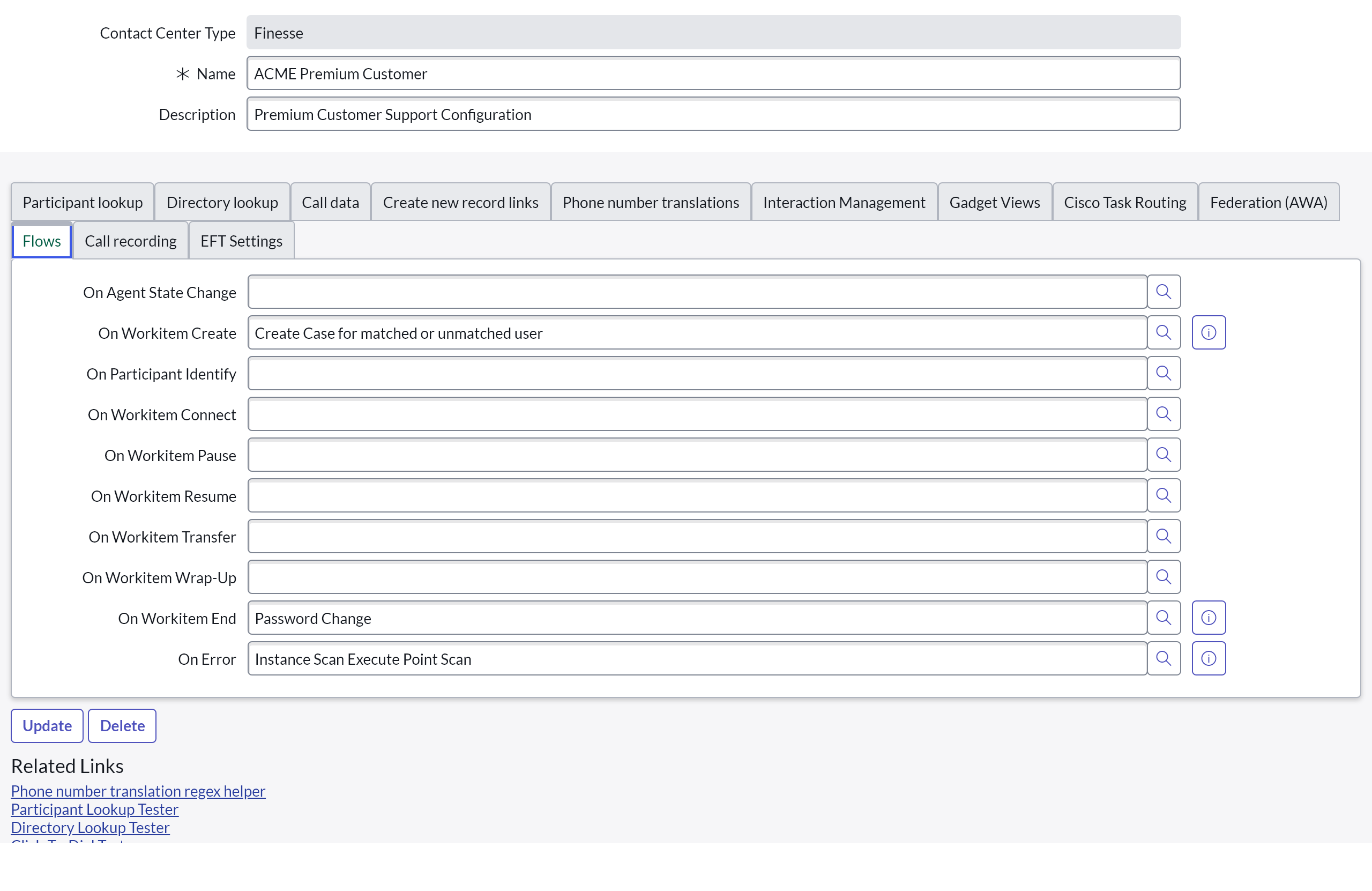
This section enables the configuration of ServiceNow subflows that are triggered on particular events occurring on the b+s Connects gadget. See Subflow Triggering for more information.
On Agent State Change
Choose the subflow that should be triggered in case of an agent state change. See Agent State Change Events for the input variables that can be used in the corresponding flow.
Required: No
Default value: Empty
On Workitem Create
Choose the subflow that should be triggered when a workitem (e.g. a call) is created (Ringing). See Workitem events for the input variables that can be used in the corresponding flow.
Required: No
Default value: Empty
Be aware that a reload of the gadget during an active workitem is triggering an additional On Workitem Create event.
On Participant Identify
Choose the subflow that should be triggered when a workitem's (e.g. a call) participant is identified. See Workitem events for the input variables that can be used in the corresponding flow.
Required: No
Default value: Empty
On Workitem Connect
Choose the subflow that should be triggered when a workitem (e.g. a call) is connected/answered. See Workitem events for the input variables that can be used in the corresponding flow.
Required: No
Default value: Empty
On Workitem End
Choose the subflow that should be triggered when a workitem (e.g. a call) is ended. See Workitem events for the input variables that can be used in the corresponding flow.
Required: No
Default value: Empty
On Workitem Pause
Choose the subflow that should be triggered when a workitem (e.g. a call) is paused. See Workitem events for the input variables that can be used in the corresponding flow.
Required: No
Default value: Empty
On Workitem Resume
Choose the subflow that should be triggered when a workitem (e.g. a call) is resumed. See Workitem events for the input variables that can be used in the corresponding flow.
Required: No
Default value: Empty
On Workitem Transfer
Choose the subflow that should be triggered when a workitem (e.g. a call) is transferred. See Workitem events for the input variables that can be used in the corresponding flow.
Required: No
Default value: Empty
On Workitem Wrap-Up
Choose the subflow that should be triggered when the agent enters the Wrap-Up state after a workitem (e.g. a call) has ended. See Workitem events for the input variables that can be used in the corresponding flow.
Required: No
Default value: Empty
On Error
Choose the subflow that should be triggered when an error happens on the b+s Connects gadget. See Error events for the input variables that can be used in the corresponding flow.
Required: No
Default value: Empty
Call Recording
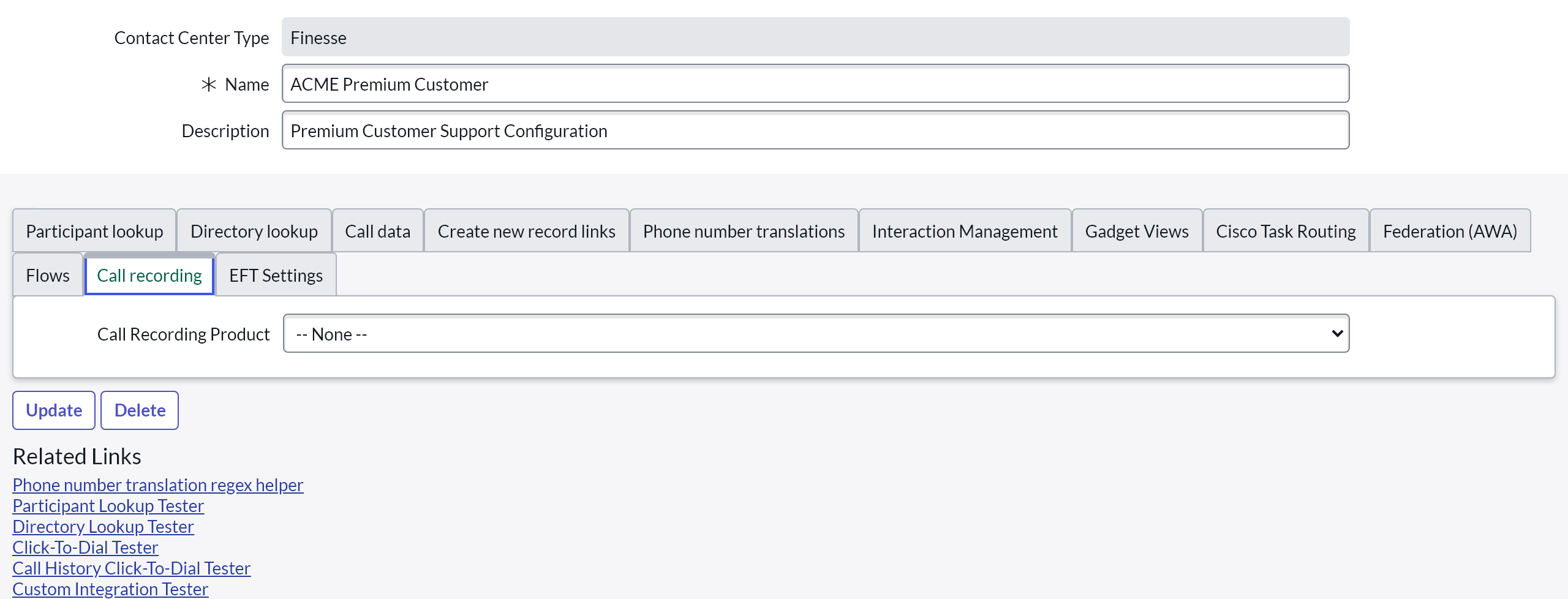
Call Recording Product
Choose the recording product which should be used to record calls. Additional configuration fields for the selected product will appear below.
Specific for Calabrio On Premise

Server Login Username
The API User's Calabrio username used to login to the Calabrio On Premise.
Required: Yes
Default value: Empty
Server Login Password
The API User's Calabrio password used to login to the Calabrio On Premise.
Required: Yes
Default value: Empty
Recording Link Field
The interaction field in which the recording link is going to be written in ServiceNow. Please create a custom field in the interaction table and then choose that field here.
This setting is only available if the automatic creation of interactions is enabled.
Required: Yes
Default value: Empty
Recording Meta Data Key
The ServiceNow Interaction ID of the current call can be written into a metadata field of the corresponding call recording on Calabrio server. This configuration value is the 'Metadata Key' of the field as created in Calabrio's 'Metadata Manager' settings.
Required: No
Default value: Empty
Recording Server
The URL where the Calabrio on Premise system can be accessed.
Required: Yes
Default value: Empty
Show recording controls
Enable or disable the call controls in an active call.
Required: No
Default value: True
Specific for Verint
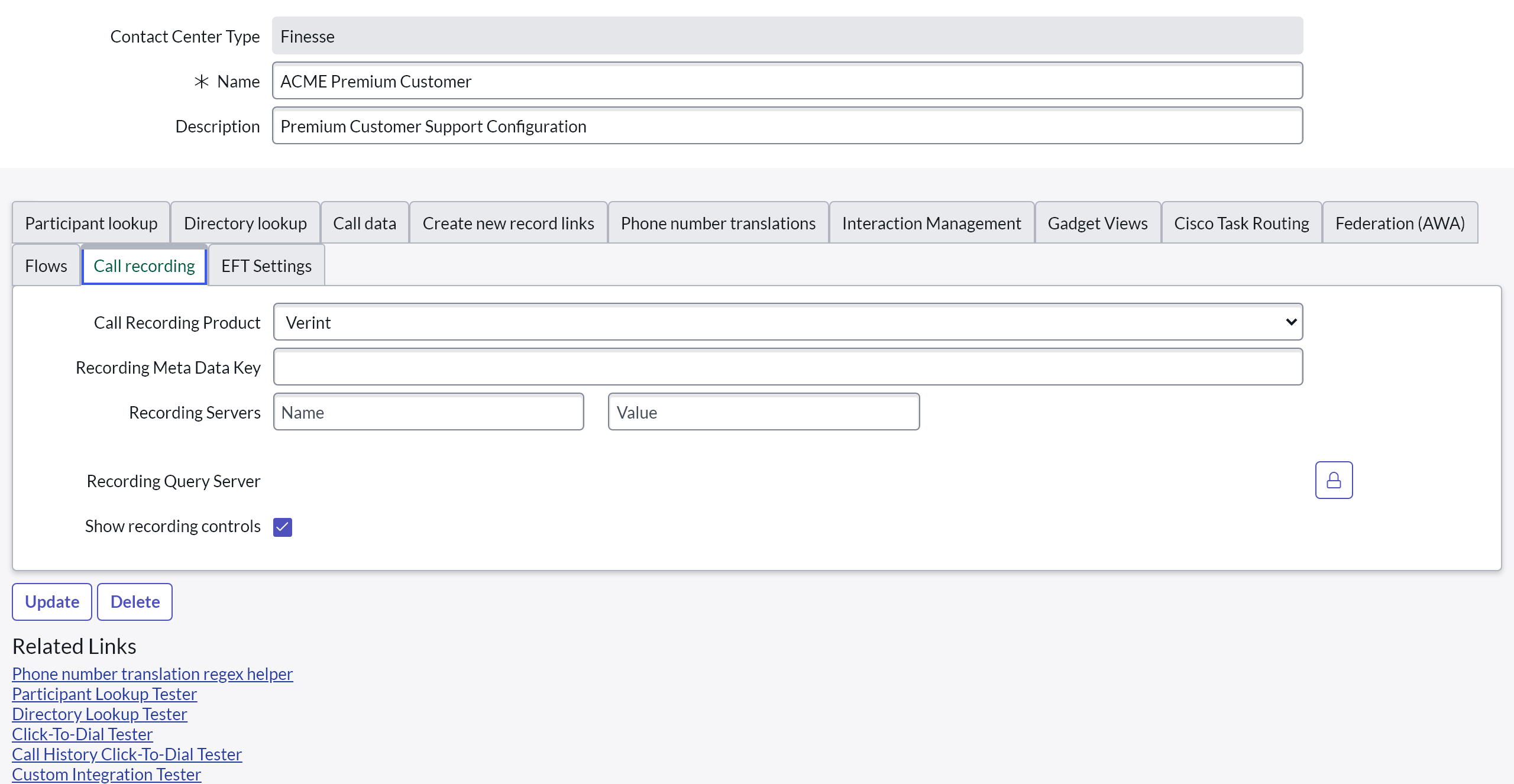
Recording Link Field
The interaction field in which the recording link is going to be written in ServiceNow. Please create a custom field in the interaction table and then choose that field here.
This setting is only available if the automatic creation of interactions is enabled.
Required: Yes
Default value: Empty
Recording Meta Data Key
The ServiceNow Interaction ID of the current call can be written into a metadata field of the corresponding call recording on Verint server. This configuration value is the 'Name' of the custom data attribute as created in Verint's 'Recording Manager' settings.
Required: No
Default value: Empty
Recording Servers
The URL(s) where the Verint server(s) can be accessed. Use the + button to add additional entries.
Required: Yes
Default value: Empty
Recording Query Server
The URL where the Verint recordings can be searched. This URL will be used to build the recording link saved into the interactions.
Required: Yes
Default value: Empty
Show recording controls
Enable or disable the call controls in an active call.
Required: No
Default value: True
EFT Settings
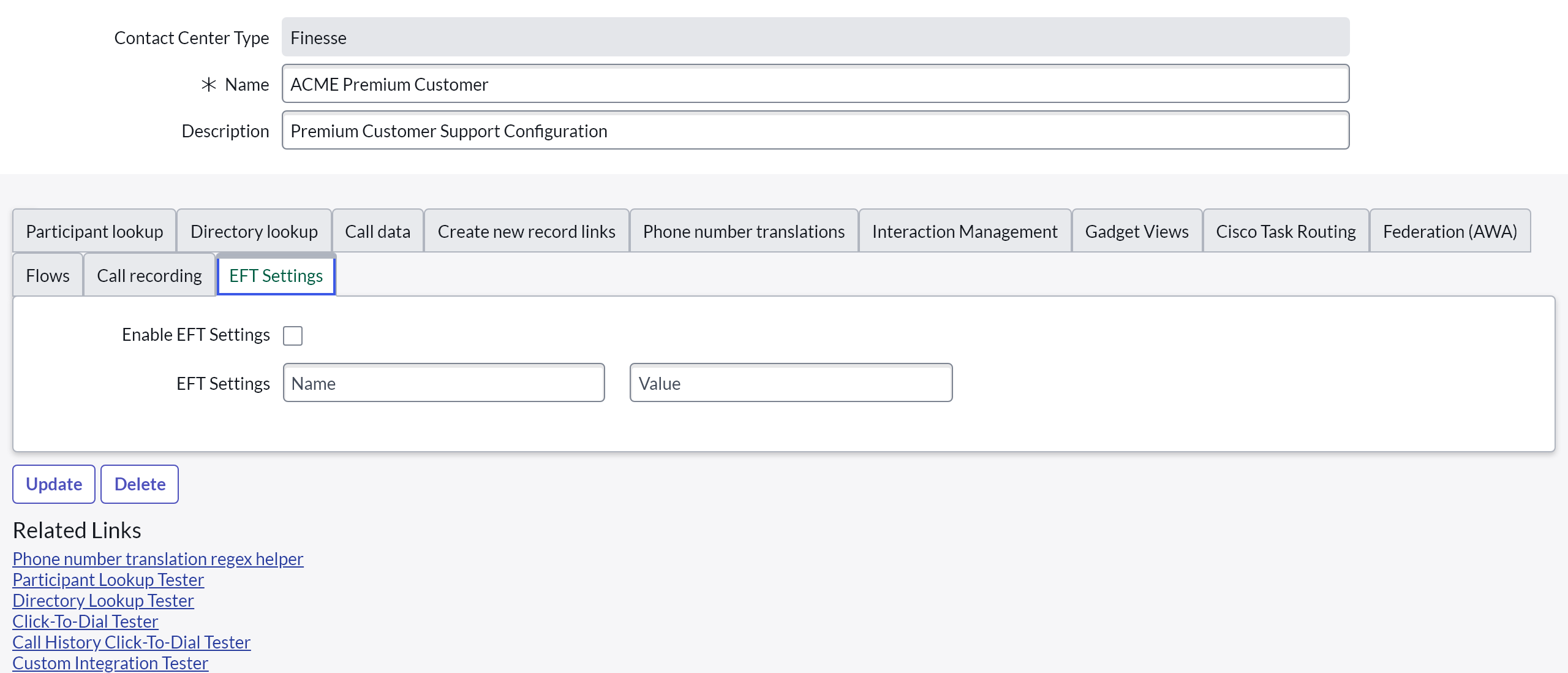
Enable EFT Settings
Enable or disable the entered EFT Settings. Early Field Trial Settings allow ServiceNow admins to already use CDN published features which would be available in the next Store release.
Required: No
Default value: False
Available EFT Settings
ssLookupMinimalLength
This EFT setting can be used to define the minimal number of characters that have to be entered in the search field to trigger a directory lookup. This is useful especially when the table being searched has a large number of entries.
Required: No
Default value: 2
Key: ssLookupMinimalLength (must match exactly)
ssLookupStartDelay
This EFT setting can be used to define the time in milliseconds to wait between the agents search input and the execution of the directory lookup. This is useful especially when the table being searched has a large number of entries.
Required: No
Default value: 300 (milliseconds)
Key: ssLookupStartDelay (must match exactly)
ssCallHistoryCtdRegex
With this EFT setting it is possible to define a phone number translation rule that will only be applied when performing a click-to-dial action from the call history view within the b+s Connects for ServiceNow gadget.
For more information on how to create phone number translation rules see Phone Number Translations.
Required: No
Default value: Empty (must be a valid phone number translation rule)
Key: ssCallHistoryCtdRegex (must match exactly)